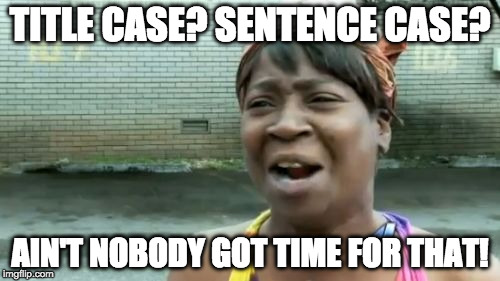
How to capitalize your titles and headlines
By Bri Hillmer on Writing docs from September 20, 2016
I sat down to write a post with a bunch of content ideas swimming in my head when I noticed that my fellow KnowledgeOwl bloggers were using different casing for their blog titles than I have. I chatted Marybeth (KnowledgeOwl's CEO) and the following conversation ensued (edited for brevity).
bri: I'm working on my article for tomorrow
and noticed I don't follow the same casing as other bloggers
marybeth: casing?
bri: for titles
marybeth: What do you think we should do?
I think it’s a personal preference? I think title case is more
difficult to read in our particular format
like when browsing the blog: https://www.knowledgeowl.com/home/blog
but I also title cased one of my own blogs
so I’m very inconsistent
bri: I don't really mind just thought it should be consistent
marybeth: Do I have to choose?
bri: hahaha you don't want me to
marybeth: Let me ask Pete (Pete is KO's CTO)
I’m sure he really cares about this
marybeth: He does actually have lots of opinions
bri: oh good!
marybeth: Haha, this could be a great article
your intro could literally be this conversation
There you have it, folks. This is how blog topics are conceived.
Please don't be insulted by the frivolity. You see, I've been the documentation coordinator at SurveyGizmo for almost 4 years now and I still don't have an answer this very simple question. This is pretty embarrassing, but, the fact of the matter is I haven't had a grammar class since middle school; and, frankly, I always felt like I have bigger fish to fry.
See? There's another blog post! I used HubSpot's article on Memejacking[1] to learn how to best reference one of my favorite memes.
This is actually the perfect fodder for a blog post. I'll do some research, present the research so you can quickly make a decision about casing for articles in your blogs and documentation.
What Are My Casing Options?
(Note to self: I need to also research casing for Headings.) So let's cover your casing options.
While there are a bunch of casing options [2], when it comes to content for the web you need to choose between title case and sentence case.
This is sentence case
This Is Title Case
Title Case
Depending on the style guide you reference the rules for title casing vary.
The Associated Press Stylebook (AP Style) is often used by news organizations. The Chicago Manual of Style (Chicago Style) is more comprehensive for in-depth writing. The American Psychological Association (APA)/Modern Language Association (MLA) Style Guides are the go-to style guides for academia.
Unfortunately, there is no single authoritative style guide when it comes to capitalizing headlines and titles; This is probably where most of our confusion comes from.
General Title Case Rules:
As mentioned, all style guides are not the same, but there are a few general rules they all follow. These are:
- Capitalize the first word in the title
- Capitalize the last word in the title
- Capitalize the important words in the title
What are "important" words? In most cases, they include the following words:
- Adjectives (e.g., quick, large, hopeful)
- Adverbs (e.g., forcefully, silently, hurriedly)
- Nouns (e.g., software, button, article)
- Pronouns (e.g., they, she, he)
- Subordinating conjunctions (e.g., as, so, that)
- Verbs (e.g., click, write, review)
Sentence Case
Sentence case is when you only capitalize the first letter of the first word – like you would in a typical sentence. The rest of the title would be in lower case, except for proper nouns.
Why Does It Matter?
Maybe it doesn't. I've gotten by for nearly four years without researching my choices or making a decision. In all seriousness, it probably matters more than I would like to admit.
Readability
Title-case advocates argue that because capital letters are more prominent title case is easier to scan.
Sentence-case advocates argue that sentence casing creates a feeling of dialogue and is more engaging. They also argue it is the best choice for more than a few words as it is more readable.Design and Usability
Casing has design and usability implications. Some argue that title casing is more symmetrical and has more gravitas and importance.
Others argue that sentence casing is friendlier for users and easier to writers to follow.
Consistency and Fostering Trust
I think the long and short of it is that you need to be consistent. Inconsistency is distracting. Beyond distraction you want to foster trust; if your readers are grammarians your haphazard casing is probably not helping you in this endeavor.
Standing On The Shoulders Of Giants
While chatting with Marybeth about what we should do with titles in the KnowledgeOwl blog we quickly resorted to researching the casing of blogs and documentation that other SaaS companies use. Here's what we found.
| Company | Blog Casing | Documentation Casing |
|---|---|---|
| HelpScout | Title Case | Sentence Case |
| Intercom | Sentence Case | Sentence Case |
| Baremetrics | Sentence Case | Title Case |
| Groove | Title Case | Title Case |
| Apple* | Sentence Case | Sentence Case |
| Sentence Case | Sentence Case |
*Interestingly, when it comes to UI Apple uses title case.
What Do You Think?
We need to make a decision about the KnowledgeOwl blog; we'd love to hear from you. Answer the survey below (don't let the casing of this post sway you).
Don't Have Time To Think About Casing?
Bookmark one of these tools.

https://headlinecapitalization.com/

I also really like the title-case cheat sheet bottom of this post:
http://georgebanis.com/blog/how-to-write-a-blog-post-title-in-the-right-case/


Writing docs
(253)

General posts useful to all documentarians about writing documentation, editing and publishing workflows, and more.


Feature spotlight
(15)

Your flight plan for how to get the most out of KnowledgeOwl features and integrate them into your workflows.


Announcements
(21)

Major KnowledgeOwl company announcements.


Customer stories
(9)

Learn how others are using KnowledgeOwl & get pro tips on how to make the most of KO!


Company culture
(40)

Find out more about who we are and what we value.


Support
(75)

We believe good support is the foundation of good business. Learn about support tools and methodology.


Tools
(64)

Learn more about tools to solve various documentarian issues, within and beyond KnowledgeOwl.


All
(384)

Not sure what category you need? Browse all the posts on our blog.

Got an idea for a post you'd like to read...or write?
We're always looking for guest bloggers.
Learn moreStart building your knowledge base today
- 30 days free (and easy to extend!)
- No credit card required
- Affordable, transparent pricing
- No cost for readers, only authors
Want to see it in action?
Watch a 5-minute video and schedule time to speak with one of our owls.



